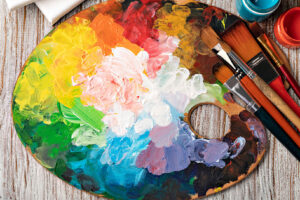The Psychology of Color in Marketing
The Psychology of Color in Marketing

Color is more than just a design choice—it’s a psychological trigger that can significantly influence how people perceive your brand, product, or message. In marketing, understanding the psychology of color gives you a powerful tool to shape consumer perception, increase conversions, and build a lasting emotional connection. Here are eight key ways color plays a role in marketing psychology.
1. Color Sets the First Impression
Studies show it takes only 90 seconds for someone to form a subconscious judgment about a product, and up to 90% of that judgment is based on color alone. Before a consumer even reads your copy or understands your offering, they’re already feeling something—thanks to color.
2. Colors Evoke Emotions
Different colors naturally evoke different emotions. Red stimulates urgency and excitement, making it popular in clearance sales. Blue instills trust and calm, which is why it’s a go-to for banks and tech companies. Green symbolizes growth and health, often used in wellness and eco-friendly branding. Choosing the right color can align your message with the emotional state you want to evoke.
3. Brand Recognition Relies on Color
Consistent use of color can increase brand recognition by up to 80%. Think about Coca-Cola’s red, Tiffany’s blue, or McDonald’s yellow and red combo. These brands have ingrained their colors into our collective memory, making them instantly recognizable even without words.
4. Gender Preferences Affect Color Choices
Research suggests that men and women perceive and prefer colors differently. Men tend to favor bold, primary colors like blue and red, while women often prefer softer tones like purple and green. Understanding your target demographic helps you choose a palette that resonates with them.

5. Color Influences Purchasing Decisions
Color doesn’t just catch attention—it can guide action. For example, red and orange are known to increase appetite and impulsivity, making them common in food and fast fashion industries. On the other hand, black implies luxury and exclusivity, often used in high-end branding. The right color can nudge a customer from consideration to conversion.
6. Cultural Context Matters
Color meanings vary across cultures. While white symbolizes purity and simplicity in Western cultures, it’s associated with mourning in parts of Asia. If your brand has a global presence or multicultural audience, understanding these nuances can help avoid mixed signals or unintended offense.
7. Contrast Affects Readability and Attention
High-contrast color combinations not only improve readability but also draw attention to key elements like calls to action or promotions. A bright button on a dark background naturally stands out and increases click-through rates. Strategic use of contrast can direct the user journey and improve engagement.
8. Color Builds Perceived Value
The right color palette can elevate a brand’s perceived value. Matte black and gold, for example, convey luxury and prestige, while pastel tones can make a product feel more accessible and friendly. Color choices can communicate your brand’s positioning without saying a word.
In marketing, color isn’t just about aesthetics—it’s about strategy. Every hue has a psychological weight, and when used thoughtfully, color can become one of the most persuasive tools in your brand’s toolkit. Ready to elevate your brand with color psychology in mind? Let’s talk strategy.


